Virtual Qualification of Electronic Hardware - NEPP - NASA
Virtual Qualification of Electronic Hardware - NEPP - NASA
Virtual Qualification of Electronic Hardware - NEPP - NASA
Create successful ePaper yourself
Turn your PDF publications into a flip-book with our unique Google optimized e-Paper software.
<strong>Virtual</strong> <strong>Qualification</strong> <strong>of</strong> <strong>Electronic</strong> <strong>Hardware</strong><br />
Dr. Michael Osterman<br />
CALCE <strong>Electronic</strong> Products and Systems Center<br />
A. J. Clark School <strong>of</strong> Engineering<br />
University <strong>of</strong> Maryland<br />
College Park, MD 20742<br />
www.calce.umd.edu<br />
CALCE <strong>Electronic</strong> Products and Systems Center University <strong>of</strong> Maryland<br />
c:\mydocuments\presentations\jpl010516.ppt
Design Capture<br />
<strong>Virtual</strong> <strong>Qualification</strong> Methodology<br />
Load<br />
Load<br />
Transformation<br />
Ranking <strong>of</strong> Potential Failures<br />
Under Life-Cycle Loads<br />
1<br />
Failure Risk<br />
Assessment<br />
2<br />
3<br />
Time to Failure<br />
CALCE <strong>Electronic</strong> Products and Systems Center University <strong>of</strong> Maryland<br />
Field<br />
c:\mydocuments\presentations\jpl010516.ppt<br />
Life-Cycle Loading<br />
Characterization<br />
Physical Verification: Test Setup, Specimen Characterization, Accelerated Stress Test
<strong>Virtual</strong> <strong>Qualification</strong> Infrastructure for Circuit Card<br />
Assemblies (CCAs) : calcePWA 3.1<br />
Computer Design Data<br />
Load Transformation<br />
Toolbox Product Modeling and Databases<br />
16<br />
14<br />
12<br />
10<br />
8<br />
6<br />
4<br />
2<br />
-2<br />
ε 2/Hz<br />
0.0000006<br />
0.0000005<br />
0.0000004<br />
0.0000003<br />
0.0000002<br />
0.0000001<br />
0<br />
Relay strain gage PSD @ 25c<br />
Acceleration History <strong>of</strong> Mars Pathfinder Landing<br />
Frequency (Hz)<br />
0<br />
2090 2100 2110 2120 2130 2140 2150 2160 2170<br />
Time (sec)<br />
Life Cycle Load<br />
Failure Risk Assessment<br />
& sensitivity analysis<br />
CALCE <strong>Electronic</strong> Products and Systems Center University <strong>of</strong> Maryland<br />
30g<br />
20g<br />
Characterization<br />
30g<br />
20g<br />
c:\mydocuments\presentations\jpl010516.ppt
Avionics Application Demonstration<br />
AS900 Engine Family<br />
<strong>Electronic</strong> Chassis<br />
<strong>Electronic</strong> hardware is to be mounted on engine and operate<br />
reliably under high temperature and vibration loading<br />
conditions. To achieve an adequate design, reliability was<br />
considered upfront in the design process and simulation<br />
techniques were applied to virtually qualify the assembly.<br />
CALCE <strong>Electronic</strong> Products and Systems Center University <strong>of</strong> Maryland<br />
c:\mydocuments\presentations\jpl010516.ppt
Steps Involved in calcePWA<br />
<strong>Virtual</strong> <strong>Qualification</strong> Assessment <strong>of</strong> CCAs<br />
• Collect design information<br />
• Develop design model<br />
• Transform environment and operation loads<br />
• Perform thermal analysis<br />
• Perform vibration analysis<br />
• Perform failure assessment<br />
• Review and verify results<br />
• Refine model (if necessary)<br />
CALCE <strong>Electronic</strong> Products and Systems Center University <strong>of</strong> Maryland<br />
c:\mydocuments\presentations\jpl010516.ppt
I/O<br />
212 Parts<br />
2122 Components<br />
10 Layer FR4<br />
Copper Metallization<br />
Design Capture<br />
AS900 Circuit Card Assemblies<br />
EMI<br />
16 Parts<br />
328 Components<br />
10 Layer FR4<br />
Copper Metallization<br />
CALCE <strong>Electronic</strong> Products and Systems Center University <strong>of</strong> Maryland<br />
c:\mydocuments\presentations\jpl010516.ppt<br />
CPU<br />
167 Parts<br />
1622 Components<br />
10 Layer FR4<br />
Copper Metallization
Design Capture and Model Development<br />
Mentor Neutral Files<br />
CALCE <strong>Electronic</strong> Products and Systems Center University <strong>of</strong> Maryland<br />
c:\mydocuments\presentations\jpl010516.ppt<br />
MS Excel Data<br />
Design information was capture using import facility in calcePWA.<br />
Subsequent data processing <strong>of</strong> part information was done in spreadsheets<br />
and within s<strong>of</strong>tware. Material data from calcePWA library was used in<br />
modeling board and component structures.
Design Capture: Part Models<br />
Package<br />
Effective Material<br />
Attach Positions<br />
Interconnect<br />
Pad Size<br />
Lead Geometry<br />
Attach<br />
Joint Height<br />
Pad Size<br />
Operational<br />
Power dissipation<br />
CALCE <strong>Electronic</strong> Products and Systems Center University <strong>of</strong> Maryland<br />
c:\mydocuments\presentations\jpl010516.ppt
Design Capture: Board Model<br />
Board<br />
Vias<br />
CALCE <strong>Electronic</strong> Products and Systems Center University <strong>of</strong> Maryland<br />
c:\mydocuments\presentations\jpl010516.ppt<br />
Layered Structure<br />
Signal<br />
Dielectric<br />
Regions <strong>of</strong><br />
Inserts<br />
Drill Size<br />
Plating Thickness<br />
Pad Diameter<br />
Plating Material
Use<br />
Category<br />
Section 1<br />
Section 2<br />
Life Cycle Loading Characterization<br />
The temperatures shown in Table 1 were taken as inputs to the thermal analysis.<br />
Section 1 and section 2 are combined to account for one cycle.<br />
Tmin<br />
( 0 C)<br />
9.5<br />
12.5<br />
Tmax<br />
( 0 C)<br />
49<br />
82<br />
AS900 nominal<br />
temperature pr<strong>of</strong>ile for<br />
one cycle<br />
Temperature ( o Temperature ( C)<br />
o Temperature ( C)<br />
o C)<br />
Ramp time to<br />
Tmax/ to Tmin<br />
35 min/ 35 min<br />
50 min/ 15 min<br />
120<br />
100<br />
80<br />
60<br />
40<br />
20<br />
0<br />
-20<br />
-40<br />
-60<br />
Section 1<br />
Dwell at Tmax<br />
/Tmin<br />
25 min /30 min<br />
35 min /30 min<br />
Table 1. Sections <strong>of</strong> one thermal cycle<br />
Time <strong>of</strong><br />
Cycles<br />
175 min<br />
160 min<br />
CALCE <strong>Electronic</strong> Products and Systems Center University <strong>of</strong> Maryland<br />
c:\mydocuments\presentations\jpl010516.ppt<br />
Total time<br />
365 days/ 10<br />
year<br />
365 days/ 10<br />
year<br />
0 50 100 150 200 250<br />
Time (minutes)<br />
Section 2
Load Transformation: Thermal Assessment<br />
CALCE <strong>Electronic</strong> Products and Systems Center University <strong>of</strong> Maryland<br />
c:\mydocuments\presentations\jpl010516.ppt<br />
Thermal analysis<br />
results with an<br />
aluminum heat sink<br />
in the backside. The<br />
thermal analysis was<br />
simulated with pure<br />
conduction with no<br />
heat loss from the<br />
top and bottom<br />
surfaces.<br />
Thermal<br />
Model<br />
CPU board<br />
I/O board<br />
EMI board<br />
Total Power<br />
29.9<br />
8.7<br />
0.6
Load Transformation: Thermal Analysis Results<br />
CPU model at 82 °C ambient temperature and up-hold nominal power<br />
Thermal<br />
Model<br />
CPU board<br />
I/O board<br />
EMI board<br />
CALCE <strong>Electronic</strong> Products and Systems Center University <strong>of</strong> Maryland<br />
c:\mydocuments\presentations\jpl010516.ppt<br />
Max Temp.<br />
(° C)<br />
94.0<br />
84.5<br />
82.1
Comparison with Experimental Result<br />
Percent Diffrence<br />
10<br />
5<br />
0<br />
-5<br />
-10<br />
-15<br />
Simulation verus Experimental Results<br />
U90<br />
U114<br />
CR47/CR48<br />
CR35/CR38<br />
CALCE <strong>Electronic</strong> Products and Systems Center University <strong>of</strong> Maryland<br />
U34<br />
Selected Parts<br />
U66<br />
c:\mydocuments\presentations\jpl010516.ppt<br />
U46<br />
U56
Defining the Life Cycle Stress Pr<strong>of</strong>ile<br />
Stress pr<strong>of</strong>ile was created using<br />
results <strong>of</strong> the thermal analysis runs<br />
considering the electronics be<br />
operational full time.<br />
CALCE <strong>Electronic</strong> Products and Systems Center University <strong>of</strong> Maryland<br />
Temperature ( o Temperature ( C)<br />
o Temperature ( C)<br />
o C)<br />
120<br />
100<br />
80<br />
60<br />
40<br />
20<br />
0<br />
-20<br />
-40<br />
-60<br />
Section 1<br />
0 50 100 150 200 250<br />
Time (minutes)<br />
c:\mydocuments\presentations\jpl010516.ppt<br />
Section 2
Failure Risk Assessment: Selecting Failure Models<br />
and Sites<br />
Failure Model Selection<br />
Once a Life Cycle Stress Pr<strong>of</strong>ile Database has been selected and the<br />
analysis mode and related information defined, the s<strong>of</strong>tware will<br />
automatically screen the data to determine the set <strong>of</strong> applicable failure<br />
models. At this point, you can then review available failure sites.<br />
CALCE <strong>Electronic</strong> Products and Systems Center University <strong>of</strong> Maryland<br />
PWB<br />
R x<br />
Componen<br />
t<br />
R y<br />
c:\mydocuments\presentations\jpl010516.ppt
Handling Multiple Environments for the Same<br />
Failure Site<br />
Damage is defined as the percent <strong>of</strong> life removed from a functional structure. If<br />
we assume that data is accumulated in a linear fashion, then we can define a<br />
damage index as<br />
where n is the applied time and N is the survivable time. Failure is defined if<br />
n ≥ N or D ≥1<br />
.<br />
For multiple environments and the same failure site and mechanism. We can<br />
define the total damage as the sum <strong>of</strong> the damage indices for the individual<br />
environments or<br />
Dtotal=<br />
∑Di<br />
i<br />
Failure is assumed to occur when<br />
D=<br />
n<br />
N<br />
Dtotal<br />
Caveat: The assumption <strong>of</strong> linear may not be valid for different failure mechanisms. One<br />
needs to understand the physical failure phenomenon to accurately determine the effect <strong>of</strong><br />
multiple environmental factors.<br />
CALCE <strong>Electronic</strong> Products and Systems Center University <strong>of</strong> Maryland<br />
≥1<br />
c:\mydocuments\presentations\jpl010516.ppt
PDF<br />
Handling Uncertainty in Input Data<br />
Material Properties Geometry Loads<br />
PDF<br />
t = 0 FFOP<br />
PDF<br />
Failure Distribution<br />
CALCE <strong>Electronic</strong> Products and Systems Center University <strong>of</strong> Maryland<br />
PDF<br />
Monte Carlo Simulation on Failure Model<br />
Time to Failure<br />
c:\mydocuments\presentations\jpl010516.ppt<br />
PDF<br />
Damage Coefficients
Table Display<br />
Once the Life<br />
Pr<strong>of</strong>ile and Failure<br />
Models and Sites have<br />
been selected, save the<br />
analysis problem to file<br />
and start the analysis by<br />
selecting Evaluate<br />
button.<br />
Failure Risk Assessment - Results<br />
Results are presented<br />
through both tabular and<br />
color coded graphical<br />
displays. More detailed<br />
information is available<br />
for each failure site.<br />
PWA display<br />
CALCE <strong>Electronic</strong> Products and Systems Center University <strong>of</strong> Maryland<br />
c:\mydocuments\presentations\jpl010516.ppt<br />
Site Text Report<br />
Sensitivity Plots
Failure Risk Assessment - Results<br />
Analysis indicates several design weaknesses: In particular<br />
Clock Oscillator<br />
1206 Chip Resistors<br />
Transistor (SOT23).<br />
Assessment indicates that these parts will not survive the<br />
design requirement.<br />
CALCE <strong>Electronic</strong> Products and Systems Center University <strong>of</strong> Maryland<br />
c:\mydocuments\presentations\jpl010516.ppt
Temperature<br />
Cycle<br />
•-50 °C to 125 °C<br />
Temp limits<br />
•10 min. Dwell time<br />
•15 °C/min ramp rate<br />
•~45 cycles per day<br />
Review and Verification: Physical Test<br />
Temperature (C)<br />
140<br />
120<br />
100<br />
80<br />
60<br />
40<br />
20<br />
0<br />
-20<br />
-40<br />
-60<br />
0 10 20 30 40 50 60 70 80 90<br />
Time (min)<br />
Board was inspected every 100 cycles until visible failure was<br />
noticed under magnification. Subsequent inspection was every<br />
50 cycles.<br />
CALCE <strong>Electronic</strong> Products and Systems Center University <strong>of</strong> Maryland<br />
c:\mydocuments\presentations\jpl010516.ppt
Analysis <strong>of</strong> Failed Test Specimens<br />
Accelerated test confirmed<br />
these weaknesses. Visible<br />
cracking <strong>of</strong> solder joints was<br />
observed at 300 cycles.<br />
Fatigue Failure <strong>of</strong> Clock Oscillator<br />
Fatigue Failure <strong>of</strong> 1206 Chip Resistor<br />
Cross-Section <strong>of</strong> Clock Oscillator Joint<br />
CALCE <strong>Electronic</strong> Products and Systems Center University <strong>of</strong> Maryland<br />
c:\mydocuments\presentations\jpl010516.ppt
Other demonstrations <strong>of</strong> virtual qualification<br />
<strong>NASA</strong>-JPL<br />
• Assessed four circuit cards<br />
assemblies (CCAs).<br />
• Matched thermal analysis<br />
results.<br />
• Confirmed robustness <strong>of</strong><br />
design<br />
JSTARS Ground Station<br />
• Compared commercial<br />
and ruggedized designs<br />
• Recommended commercial<br />
processor circuit card<br />
• Estimated saving $1.2M<br />
Tri-Service Radio<br />
• Assessed three production CCAs<br />
• Determined design would not meet<br />
life objective.<br />
• Design change resulting in $25M<br />
AAAV<br />
• Assessed two <strong>of</strong> CCAs<br />
• Provided test plan<br />
Bradley Fire Support Vehicle<br />
• Assessed 15 CCAs<br />
• Identified potential problems<br />
• Confirmed vibration simulation<br />
results through test.<br />
Automotive<br />
• Assessed and tested CCA<br />
• 83% reduction in design issues<br />
• 10% reduction in time to market<br />
Life Life Cycle PoF PoF Analysis Provides Considerable ROI ROI<br />
CALCE <strong>Electronic</strong> Products and Systems Center University <strong>of</strong> Maryland<br />
c:\mydocuments\presentations\jpl010516.ppt
Summary<br />
• Reliability <strong>of</strong> product can be improved dramatically by<br />
conducting virtual qualification prior to building hardware.<br />
• Automated s<strong>of</strong>tware can be used to facilitate assessment<br />
process.<br />
• Damage and stress models are effective for identifying<br />
intrinsic design deficiencies and for providing a relationship<br />
between test and field failures.<br />
• Physical testing should be used to verification that<br />
simulation adequately captured the anticipated failures sites.<br />
CALCE <strong>Electronic</strong> Products and Systems Center University <strong>of</strong> Maryland<br />
c:\mydocuments\presentations\jpl010516.ppt



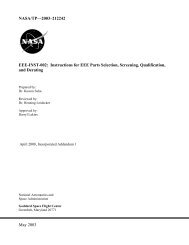

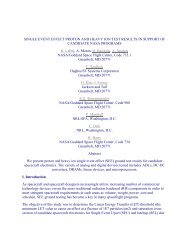
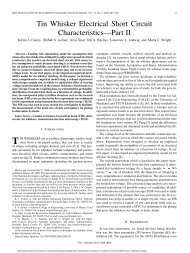
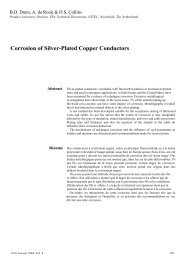
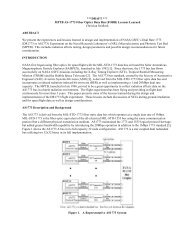

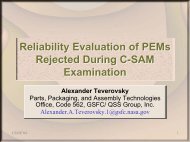
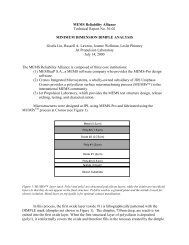
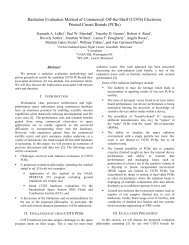
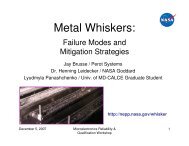
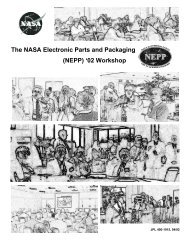
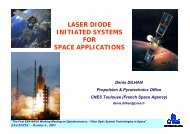
![mil-std-2223 [test methods for insulated electric wire] - NEPP](https://img.yumpu.com/4036001/1/190x249/mil-std-2223-test-methods-for-insulated-electric-wire-nepp.jpg?quality=85)